After a day of running around, you are finally ready to hit the bed. But once you’re there, your brain just doesn’t “shut down”. You toss and turn, staring up at the ceiling. You might be thinking, “Am I doomed for another night of insomnia?”
It’s a problem that’s a lot more common than you think. The Sleep Foundation Organisation estimates that 35% of the general population has trouble sleeping. Interestingly, a poll done by the same organisation found that adults aged 18-29 often experienced insomnia more than other age groups.
The solution to this problem? Meditation.
Table of Contents: Getting Started With Guided Sleep Meditation for Insomnia
Why Meditation?
Meditation has been known for a very long time to help people who struggle with sleep. Meditation can help calm your mind and body, which primes you for a good night’s sleep. It can also help in reducing stress or anxiety by giving you a break from sensory stimulation.
What is Guided Meditation?
Guided meditation involves using audio clips where someone leads you through the process. Your teacher or host can lead you through a meditative session where they explain relaxation techniques, breathing exercises, and more! Over the last few years, more people are turning to guided meditation to get a healthy night's sleep.
Why Guided Meditation?
Guided meditation is perfect for people who are new to meditation because you get a guide who can help you perfect your technique. This ensures that you get the most out of each session. The practice usually involves focusing your mind on the present and being self-aware. This can be hard for people who are more used to letting their minds wander. So meditating with a guide can help to provide direction which helps to create non-intruding thoughts.
With the advancement of technology, there are even many apps and online resources out there which exist solely to help you carve out and utilise the 5 minutes you need to meditate while you’re busy and on-the-go.
Most have guiding words at the beginning, which eventually fade out, leaving you with soft, soothing music to help you drift off to sleep.
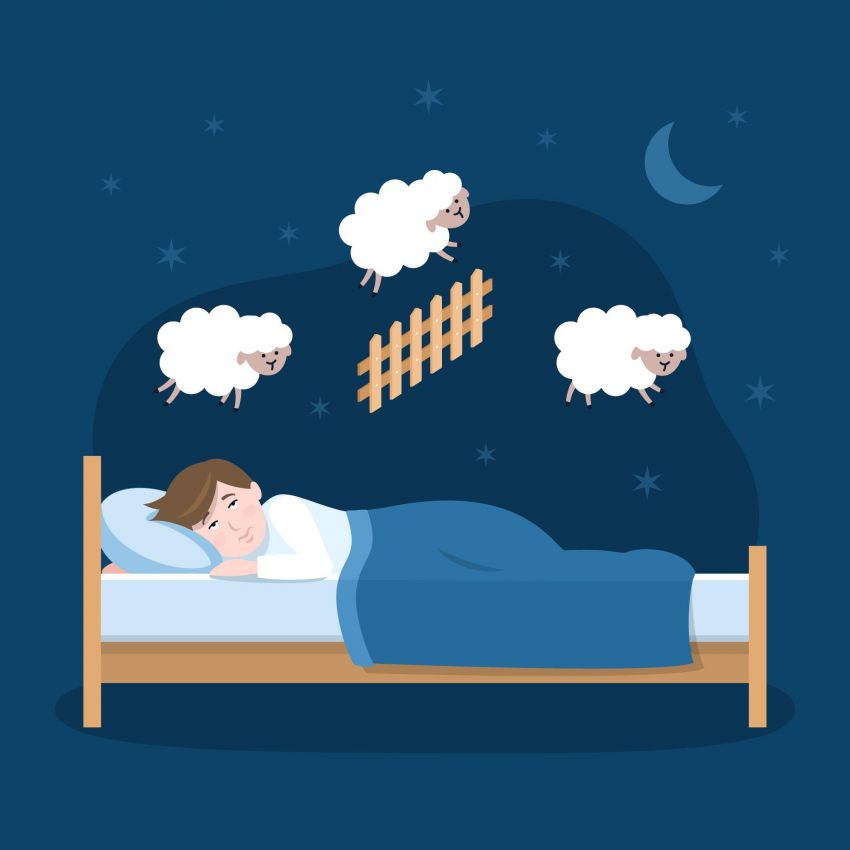
Different Types of Guided Meditation
When you mention guided meditation, most people think of coaches on apps with soothing voices. But guided meditation has a lot more variety. There are a total of four different types of guided meditation and as a beginner, feel free to explore and play around to find out which type fits you the best. Here is a helpful guide to them:
1) Deep Relaxation
Probably the most common of the four, deep relaxation meditations aim to calm your body and mind. Often, your coach will guide you through a body scan, where you take turns to relax each body part. This helps to prepare your brain and body for sleep mode by giving you a chance to experience less stimulation. Sometimes, your coach can opt for background music to help set the tone as well.
Our tip for the body scanning part is to remember to be patient with yourself. The mind tends to wander, and it’s completely okay for you to get distracted during your meditation. The point of meditation is not to be perfect, so allow yourself to relax without expecting anything of yourself.
The benefits of deep relaxation are that it’s very easy to follow along as you just need to listen to the instructions of your coach. Additionally, it usually requires you to lay down for the body scanning part so you can go straight to sleep after it’s over!
2) Binaural Beats
This next one is a little more technical in the way it works. Meditation using binaural beats uses the science of frequencies to trigger sleepiness in your brain. These frequencies help to slow down your brain activity and thus, make you sleepy. We highly recommend using headphones for this type of meditation to get the most out of it.
Another benefit of binaural beats is that it helps to raise sleep-promoting hormones. This means that if you stay consistent with your meditation, you will find it a lot easier to fall asleep. Binaural beats can also help reduce the feeling of pain that might be keeping you awake.
3) Hypnosis
Hypnosis has been used a lot in media and pop culture, which has given it a bit of a reputation for being a mind-control device. But don’t be fooled, hypnosis is very safe and a lot more common than you would think. (So no, you will not be in your own version of “Get Out”.)
Using hypnosis for sleep meditation mostly works towards changing your views about sleep. After all, hypnosis helps to reprogram your mind towards a desired goal or behaviour. So most sleep meditations will revolve around helping you deal with stress and anxiety. You can even include positive affirmations to yourself during this time as they are more likely to stick!
4) Unguided Meditation
Unguided meditation is technically not part of “guided” sleep meditation. Still, we decided to add it to the list given that it is also a very common method of sleep meditation. In these types of meditation, your guide isn’t a soothing voice, but a bunch of sound recordings. Sometimes these can come in the form of soothing music or even sounds of nature, like rain. Or they can be a combination of the two.
This type of meditation is great because your mind can associate these sounds with relaxation and sleep, which helps to de-stimulate and get you ready for a good, fruitful sleep. To get the best experience, leave these recordings running in the background, like white noise.
Guided meditation is a matter of preference - it takes quite a bit of trial and error to figure out what works for you. Additionally, each type of meditation has its own goal and may also vary in duration. So play around and find out what works (or doesn’t) for you.

Best Apps for Guided Sleep Meditation
So now that you have an idea of what guided sleep meditation is and how it can help you, let’s look at where you can get started. In recent years, guided sleep meditation has become somewhat of a trend in the app market. With this, there are many places you can refer to for your dose of guided meditation.
If you are intimidated by the sheer number of apps that promote sleep meditation, don’t be! We went through the gauntlet and shortlisted 5 of our favourite apps for you.
1) Calm

Credit: Calm
This is an app that you have heard of, if not used. This app is extensive and offers sessions that last from 3 minutes to 25 minutes. The app adds new meditation exercises every day and even includes progress trackers and programs for beginners. If you already know what you want to focus on, you can skip this and go straight to sessions aimed at mindfulness, or calming anxiety. Whatever you want. The best part? It’s free for general use!
However, you might have to pay a little extra for some of the more advanced programs.
2) Simple Habit
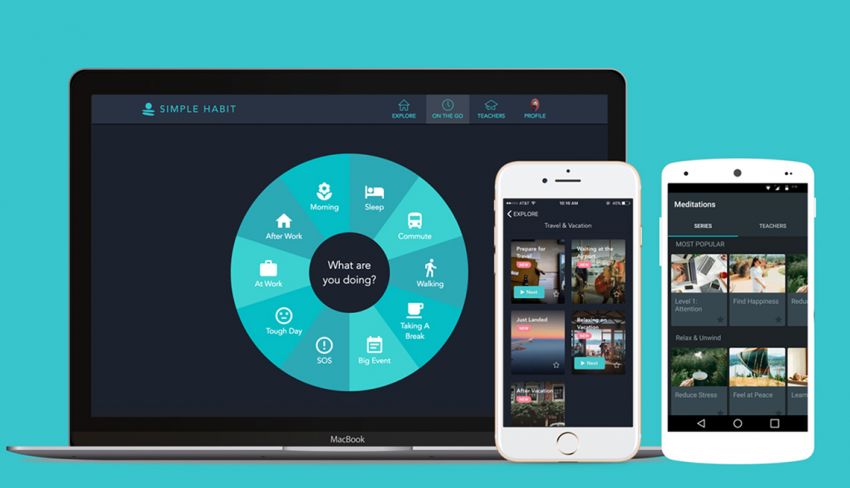
Credit: Simple Habit
Simple habit is an app with the most classic of guided meditations. All of their sessions last about 5 minutes. While their coached meditation is a staple in the app, they even have motivational guides and bedtime stories that you can listen to. This app is perfect for people who are always on the go or need to get their dose in the middle of a very busy lifestyle.
3) Ten Percent Happier

Credit: Ten Percent Happier
If you have somehow made it through this article, but are somehow still unsure if guided meditation is for you, then this next app is perfect!
Made for skeptics such as yourself, this "Ten Percent Happier" app aims to convert you by offering meditations aimed at helping users with anxiety and sleep. The app adds new content every week and has a free and premium version with the latter giving you access to more than 500 videos and even more additional content. If you are eager to have your views about meditation challenged, give this app a whirl.
4) Headspace
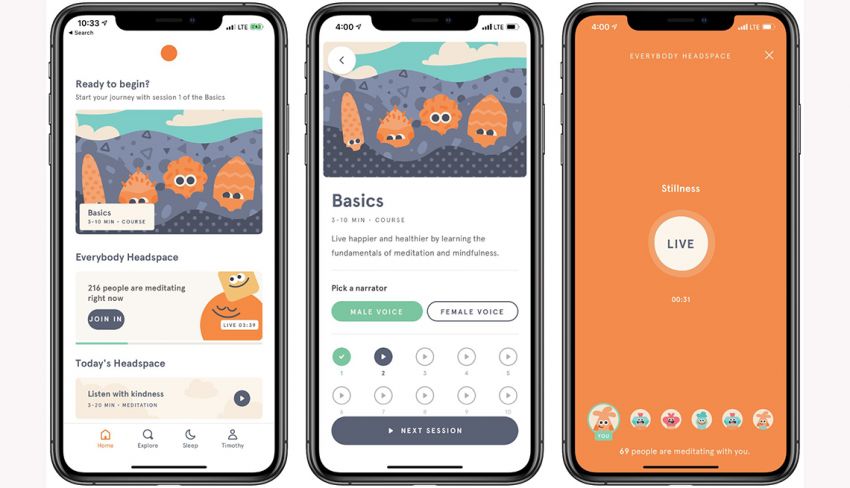
Credit: Headspace
There is no mistaking the iconic artwork of Headspace. Its aesthetically pleasing interface has made it an instant hit with the younger crowd. Headspace has hundreds of guided meditations complete with animation to help you understand meditation better. Unlike the rest of the apps on this list, Headspace is not free, but it does come at an affordable price of $7.99 per month. If you are looking to splurge a bit, their higher tiers come at $12.99 per month.
5) Stop, Breathe & Think
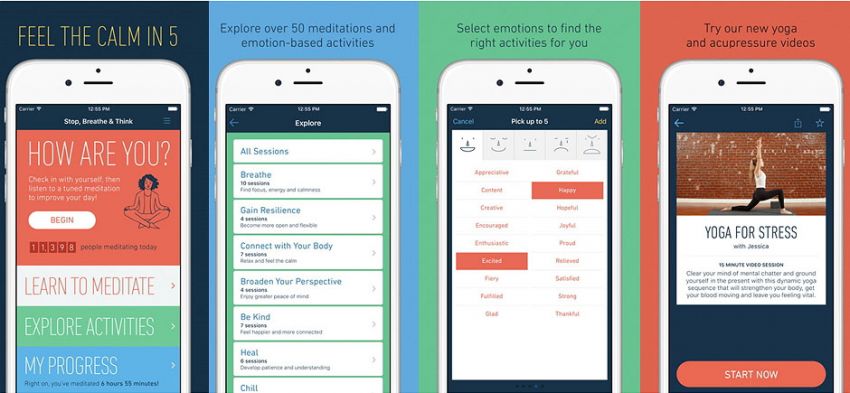
Credit: Stop, Breathe & Think
Whereas most apps can guide you in a certain direction about what sort of guided meditation to try out, “Stop, Breathe & Think” has a unique feature, their check-in. One feature of the app that stands out is that it allows you to express yourself so that it can recommend the best sessions to you.
This can be helpful if you want to get more out of your session or are not too sure about what exactly you should focus on. This app is free, but the content at this stage can be slightly restricting. You can pay a little extra to unlock many more features on the premium level. Furthermore, 10% of your money goes to helping teach kids about mindfulness!
Alternatives: Youtube Channels For Guided Sleep Meditation
So say you are not really into apps. Is there anywhere else you can go for your dose?
Absolutely!
Here are three youtube channels you can try out for your meditation needs. There are also other resources available online which you can find with a quick search but for now, here are our top picks!
1) YellowBrickCinema | A channel for Sleep Music, Relaxation Music & much more

Credit: YellowBrickCinema’s Youtube Channel
YellowBrickCinema is the leading youtube channel for sleep music. The account posts a video a day and boasts various genres of music from multiple cultures that are known to promote sleep. But it doesn’t just end there because YellowBrickCinema also has music in many other genres such as Healing Music, Study Music, Reiki Music, Zen Music, or even Spa and Massage Music. On this channel, you can find music for all of your needs no matter how specialised it may seem.
2) Jason Stephenson - Sleep Meditation Music
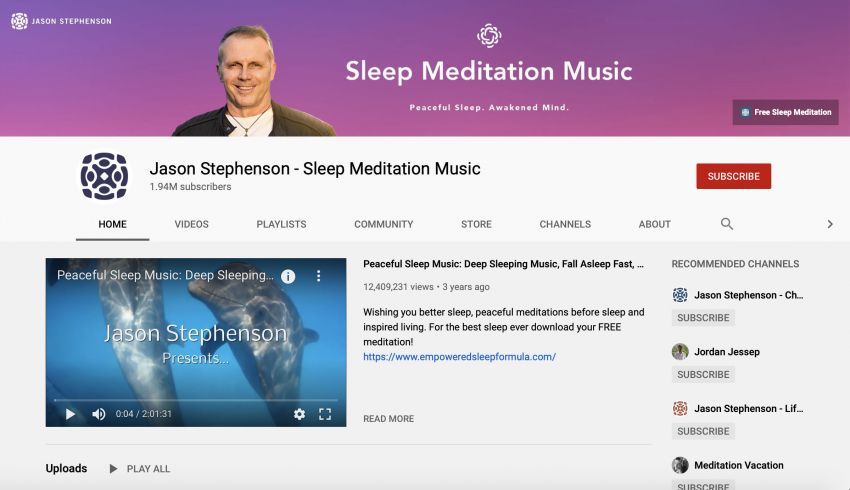
Credit: Jason Stephenson’s Youtube Channel
Jason Stephenson is the founder of Relax Me Online Australia and has been involved in the meditation field for over a decade. In fact, his methods are well known among Hollywood actors and musicians. His program is also used in Australian prisons to promote rehabilitation.
Now, he has made his recordings available for free on Youtube! On a growing channel with over 840,000 subscribers, Jason’s Youtube uses a mixture of guided visualisation, inspiring talks, and relaxation music. He has partnered with apps such as Simple Habit to promote his recordings.
3) Michael Sealey | Hypnosis - Hypnotherapy - Guided Meditation - Sleep Relaxation
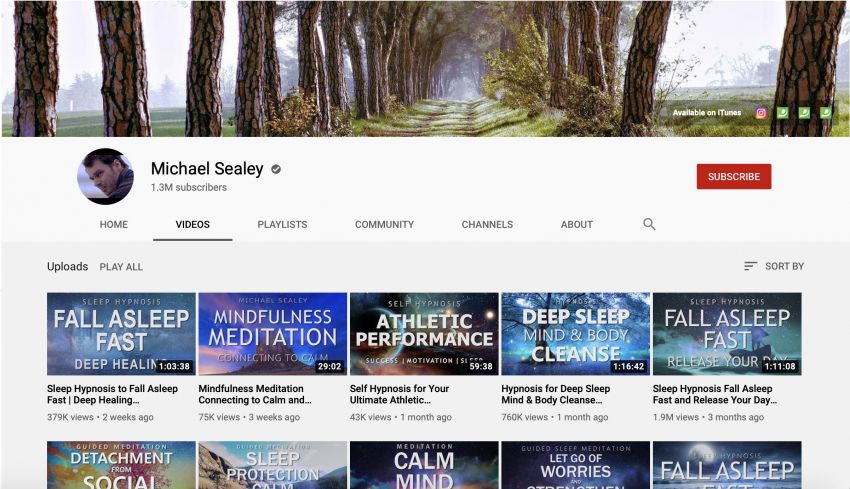
Credit: Michael Sealey’s Youtube Channel
Michael Sealey is an Australian actor who is trained and certified in Hypnosis and Clinical Hypnotherapy. He has created a variety of videos and podcasts that guide users in the areas of sleep and anxiety regarding it.
On his Youtube channel, which has a following of over 1.2 million, Michael calls hypnosis “a completely natural state of often deeply felt relaxation and focused attention, where positive suggestions can be more easily accepted by our subconscious minds.”
His videos also vary drastically in content. From guided sleep meditation to learning to detach yourself from social media, there is no niche that this channel does not cover. This is definitely a great resource for beginners who want to get started in meditation and believe that hypnosis can be helpful to them.
Bonus: Sleep Hygiene and Extra Tips
The guided meditation only works when you do it consistently, so its important to build up that habit. While you do that, here are five tips you can try out to increase your chances of a good night’s sleep.
1) Exercise
Exercising increases your body temperature, and the drop after this actually promotes sleep! This is especially true for people who exercise in the evenings. Exercising can also reduce insomnia by decreasing your levels of arousal, anxiety, and depressive symptoms. So if you can’t fall asleep, try to get yourself out for a jog earlier in the day.
2) Set a Sleep Schedule
Going to sleep at the same time and waking up at the same time may seem like an impossible task, but creating a schedule can actually be really beneficial to a regular sleep cycle. It’s also a good idea to not take a nap 8 hours before your sleep time so that your body can stay on schedule.
3) Create a Bedtime Ritual
Having a bedtime ritual can help you associate calming activities with bedtime. You can use this to make it easier to fall asleep. Some great bedtime activities can be taking a bath, reading a book, or even having a nice cup of hot chocolate. Make sure you stick to your routine, as disrupting your ritual could also make you fall back into a cycle of insomnia.
4) Don’t Just Lay There
All too often, we just lay in bed and stare at the ceiling when we can’t fall asleep. This is a horrible idea. If you have not fallen asleep in 30 minutes after you get into bed, get up and walk around. Go read or listen to music until you feel sleepy enough to get back into bed. It is better if you don’t get onto a screen at this point if it can be helped.
5) Darken Your Room
Switch off your strobe LED lights and draw your curtains. While many people sometimes opt for lighting in their room at night such as fairy lights, research has shown that small lighting, such as the glow from your clock or even LED lights from another device can go a long way in reducing sleep quality. Hence, minimise the number of disturbances in your room and go for complete darkness wherever possible.
Have a Good Rest!

With how trendy guided sleep meditation has become, it has become increasingly easier to access it as well. Meditation is great at increasing your chances of better sleep. The only challenge is figuring out the best resource for it, but hopefully, with this article, you will have a better understanding of sleep meditation and how to use it. Now get out there and catch those “ZZZs”!

















